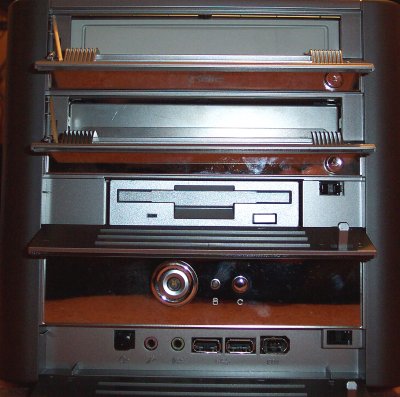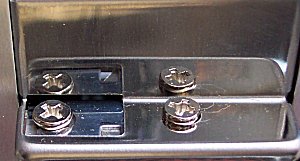External thoughts

Soltek's line of mini barebone systems fall under the banner of QBIC, which is a nice play on words. It's actually quite difficult in discerning what the QBIC is if you haven't cultivated an interest in the comings and goings of the PC hardware world. For all the untrained could tell, it may be a new jewellery box, a new-fangled toaster or mini hi-fi. That's good. Manufacturers have often sought to rid the general public of the dull beige box syndrome.


What you're looking at is the front of the nForce2-powered QBIC SL-B7A-F. Shuttle tends to use matt finishes and have the various ports and sockets on display, usually at the bottom. Soltek prefers to keep everything hidden behind a mirror finish, which, of course, smudges all too easily. That's the price you pay for sleek looks. The reflection shows the digital camera that took the shot, a couple of hands that belong to yours truly, and the top of a conservatory. Completely off-topic, but there you go.

Going from right to left, we have S/PDIF-Out, Microphone-in, Line-In. 2 x USB2.0 ports, and a single 6-pin FireWire port. We like the fact that the ports can be concealed until required, but we'd also have preferred a headphone socket on the front. Initial impressions are of impressive build quality and thoughtful design.


The Soltek barebones outfit is distinctly larger than a Shuttle XPC; we'll get on to size later. Still, Soltek decides to use a similar layout to Shuttle. The obvious difference is the lack of air-assisted heatpipe cooling showing through the back This nForce2-powered Soltek carries a single PCI slot and an 8x AGP slot, with both slot plates shown on the right. It's interesting to note, SFF-wise, that the PCI's plate doesn't have to be removed if an AGP card is going to be used; the hinged section just slides on over the top. The aluminium cover comes away via three thumbscrews, a la Shuttle XPC.

A slightly larger shot defines the features available on the back. Legacy ports, a RJ45 port, high-speed connectivity in the form of dual USB2.0 and FireWire ports are an expected part of any decent motherboard, as are the sound jacks on the right. What's more interesting, however, is Soltek's attention to the nForce2's IGP video-out ability. The EQ3702M carries dual VGA outputs and an S-Video connection, affording the user plenty of flexibility when it comes to displays. That's an important feature of any mini barebones unit.

The accompanying bundle is pretty much what you'd expect. The instruction, installation, and feature manuals are quite well written. That's an important point for novice builders attempting their first mini barebones PC build. As always, we recommend that the user leaf through the manuals to get an idea of what's involved before embarking on the actual build. We also like the attention to detail with respect to drive cabling. Limited space and the need to keep decent airflow are important considerations when designing a SFF unit. The standard cables become narrower in the middle sections. The various screws, ties and other related paraphernalia are provided, naturally. The absence of SATA cabling informs us of no support, which is a shame. The EQ3702M features S-Video out, as shown above, so we had expected some accompanying cabling. That's an oversight on Soltek's part.
Soltek devotes an entire information manual to the extra software bundled in with the EQ3702M. Specifically, it's PC-Cillin 2002, Virtual Drive 7, RestoreIT 3 Lite, Partition Magic 6.0SE and Drive Image 4.0. These aren't the latest incarnations of each line of software, but they do prove to be useful tools in managing the data transition from one hard drive to another, recovering files and managing day-to-day drive usage.









